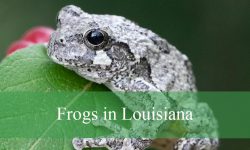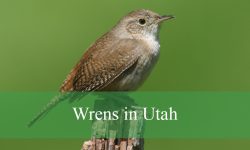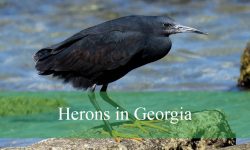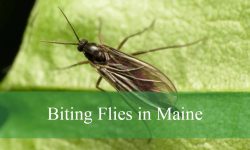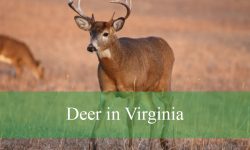Ohio’s skies are home to a fascinating variety of hawks, each with unique behaviors and stunning flight patterns. As a bird enthusiast, spotting these raptors is always a thrilling experience. Whether soaring high or perched quietly, hawks bring excitement to every nature outing.
From the soaring Red-tailed Hawk to the elusive Northern Goshawk, Ohio offers diverse habitats where these skilled hunters thrive. Learning to identify them by their calls, flight, and markings adds a rewarding challenge to any birdwatcher’s adventures.
In this guide, you’ll discover detailed information and clear photos to help you recognize 10 common hawk species in Ohio. Get ready to deepen your appreciation for these majestic birds and enhance your next outdoor exploration.
Common Hawks Found in Ohio
Red-tailed Hawk (Buteo jamaicensis)
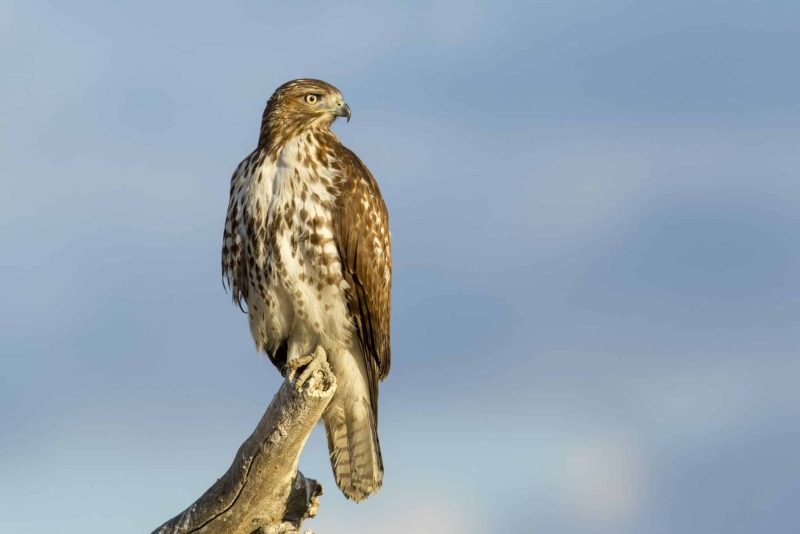
The Red-tailed Hawk is the most widespread and commonly seen hawk in Ohio. This large raptor has a bulky body, broad wings, and a short, wide tail. Adults are easily identified by their reddish-brown tail, pale underparts, and a dark band across the belly. The back and upper wings are usually dark brown, while immature birds may have a more mottled appearance with a brown tail instead of red.
This hawk typically measures between 18 to 26 inches long, with a wingspan of 45 to 56 inches. Females are generally larger than males, a common trait among raptors. Red-tailed Hawks are often seen soaring in wide circles high above open fields, highways, or perched on telephone poles scanning for prey.
Red-tailed Hawks feed primarily on small to medium-sized mammals such as mice, voles, rabbits, and squirrels. They are opportunistic hunters and may also consume birds, reptiles, and even carrion. They use their keen eyesight to detect movement from high above, then swoop down with powerful talons to grab their prey. In Ohio, they are active hunters year-round, especially visible during the fall when juveniles disperse.
These hawks nest high in trees, often in the crook of a large branch. They build large stick nests lined with bark and greenery. Red-tailed Hawks usually lay 1–3 eggs, and both parents take part in raising the young. A fun fact: the raspy scream often used in movies for eagles is actually the cry of the Red-tailed Hawk!
Red-shouldered Hawk (Buteo lineatus)
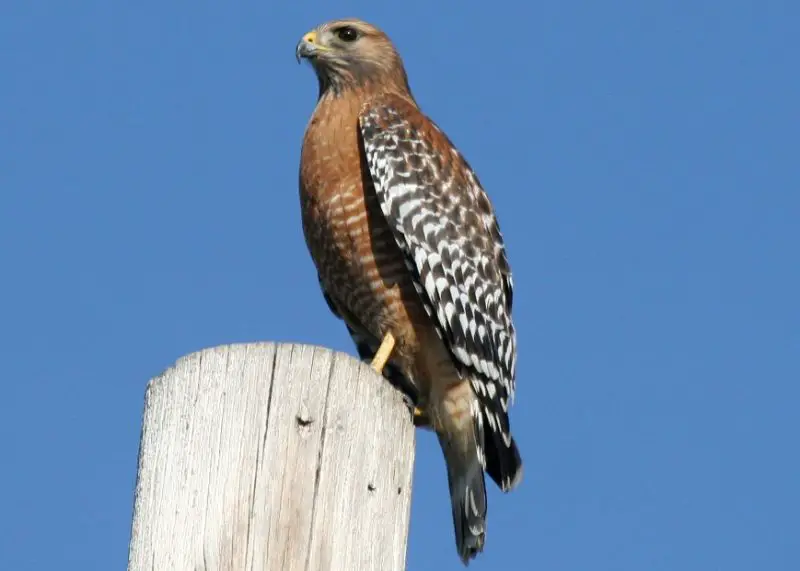
The Red-shouldered Hawk is a striking raptor with a vibrant, colorful appearance. It has reddish barring on the chest and upper body, black-and-white checkered wings, and the namesake reddish “shoulders” visible when perched. Its tail is marked with black and narrow white bands. This hawk is smaller and slimmer than the Red-tailed Hawk but still robust in build.
It typically measures 17 to 24 inches in length, with a wingspan of around 37 to 43 inches. Red-shouldered Hawks have a loud, repeated “kee-yer” call that echoes through the woods and is often heard before the bird is seen. In Ohio, they are mostly found in the eastern and southern parts of the state, where mature forests and wetlands dominate the landscape.
This species primarily hunts from a perch, waiting patiently before swooping down on prey. Their diet includes small mammals, amphibians, snakes, and occasionally crayfish, especially in wetter habitats. They are known for their adaptability in choosing food sources, which allows them to thrive in forested river corridors and swamps throughout Ohio.
Nesting high in hardwood trees, often near water, Red-shouldered Hawks reuse the same nest sites for many years. They usually raise 2–4 chicks, and both adults provide food and protection. A fun fact: Red-shouldered Hawks often cooperate with crows to drive off larger raptors like Great Horned Owls—an unusual alliance in the bird world!
Cooper’s Hawk (Accipiter cooperii)

Cooper’s Hawks are medium-sized forest hawks known for their agile flying abilities and bird-hunting prowess. They have a sleek, predatory look with rounded wings and a long, narrow tail with thick dark bands. Adults have steely blue-gray backs and reddish barring on the chest, while juveniles appear brown and heavily streaked.
They measure around 14 to 20 inches long, with a wingspan of 24 to 35 inches. Females can be nearly one-third larger than males. These hawks are fast and skillful flyers, maneuvering through dense woods with ease. In Ohio, they are common year-round residents in wooded suburbs, city parks, and forest edges.
Cooper’s Hawks specialize in hunting birds, particularly doves, robins, starlings, and sparrows. They often stake out bird feeders, using stealth and cover to surprise their prey. They may also hunt small mammals like chipmunks and squirrels. Their high-speed ambush attacks make them one of the most efficient bird predators in North America.
Their nests are well-hidden in dense trees and usually placed in a crotch or against a trunk. The female lays 3–5 eggs and does most of the incubating while the male provides food. A fun fact: Cooper’s Hawks are sometimes mistaken for Sharp-shinned Hawks, but they can be told apart by their larger heads, bulkier size, and rounded tails when flying.
Sharp-shinned Hawk (Accipiter striatus)
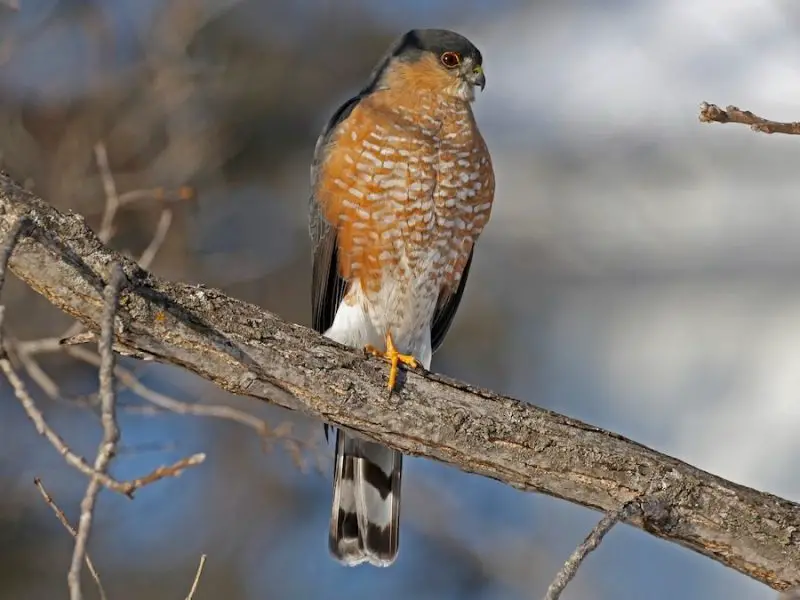
Sharp-shinned Hawks are the smallest hawks in Ohio and among the most elusive. They have short, rounded wings and long, square-tipped tails, which help them dart swiftly through thick cover. Adults are slate-gray above with reddish-orange barring on the chest, while immature birds are brown above and streaky below.
These compact hawks measure 9 to 13 inches long, with wingspans of about 17 to 22 inches. Males are notably smaller than females, a difference that can be extreme in this species. Sharp-shinned Hawks are seen in Ohio primarily during migration in spring and fall, though a few may overwinter in forested areas or near backyard feeders.
They feed almost exclusively on small songbirds, ambushing them with explosive speed and precise aerial control. They are known for their ability to fly through trees and shrubs at astonishing speeds to catch prey. Occasionally, they may also eat insects and rodents, but birds remain their primary food source.
Their nests are typically built in coniferous or mixed woodlands, usually high in dense trees. They lay 3–7 eggs, and the young fledge in about a month. A fun fact: Despite their fierce nature, Sharp-shinned Hawks sometimes fall victim to larger hawks like Cooper’s Hawks or even owls, making them both predator and prey in Ohio’s forests.
Broad-winged Hawk (Buteo platypterus)
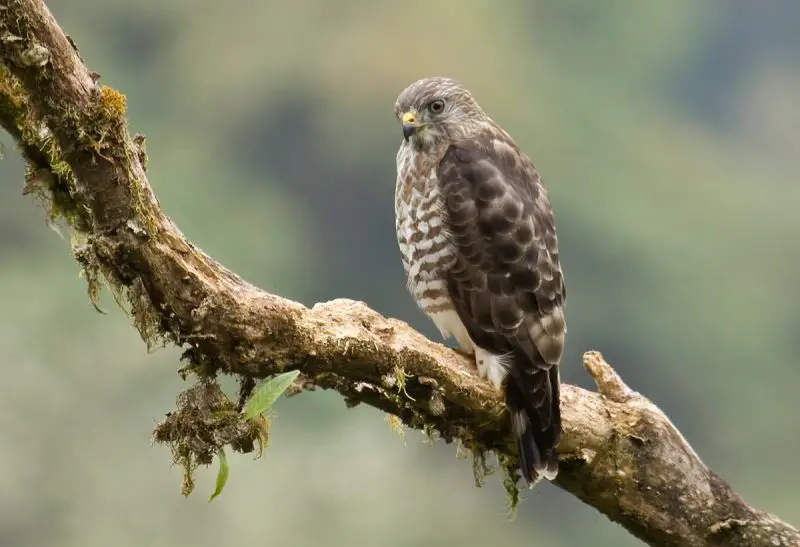
Broad-winged Hawks are small but stocky hawks with broad wings and short tails. Adults have dark brown upperparts and pale underparts with reddish-brown barring across the chest. The tail is black with bold white bands, which is a key field mark when seen from below. These hawks are most often spotted during migration rather than while nesting.
They range from 13 to 17 inches in length, with a wingspan of 29 to 39 inches. In Ohio, Broad-winged Hawks breed mainly in mature deciduous forests across the state, but they are easiest to observe in large numbers during fall migration, when thousands soar southward in tight groups known as “kettles.”
Their diet includes small mammals, amphibians, reptiles, and large insects. They hunt from low perches, scanning the forest floor for movement. Unlike Red-tailed Hawks, which prefer open terrain, Broad-winged Hawks stay hidden in dense woods during the breeding season, making them harder to spot unless they’re flying overhead.
These hawks build stick nests in large trees, typically laying 1–3 eggs. Both parents care for the young until fledging. A fun fact: Broad-winged Hawks undertake one of the longest migrations of any North American raptor—traveling over 4,000 miles to South America each fall!
Northern Harrier (Circus hudsonius)

The Northern Harrier is a distinctive hawk known for its owl-like facial disk, long wings, and long tail. It flies low over open fields and marshes with wings held in a V-shape, often gliding slowly as it searches for prey. Males are pale gray above with white undersides, while females and juveniles are brown with streaked bellies. All ages have a noticeable white rump patch, a key field mark for identification.
Northern Harriers measure 16 to 20 inches in length, with wingspans ranging from 38 to 48 inches. In Ohio, they are most frequently seen during migration and winter, though some breed in the northern and western parts of the state in extensive wetlands or grasslands. Unlike many other hawks, they rely heavily on sound as well as vision when hunting.
Their diet consists mainly of small mammals like voles and mice, but they also eat birds, frogs, and insects. They fly low over fields, listening and watching for movement. Their facial disk helps funnel sound to their ears, much like an owl’s. They may also occasionally hunt by hovering briefly before dropping down onto prey.
Northern Harriers nest on the ground in dense vegetation, building nests of sticks and grasses hidden in tall grass or reeds. Females lay 4–6 eggs and raise the chicks with food provided by the male. A fun fact: Northern Harriers are one of the few raptors in North America where polygyny is observed—one male may mate with multiple females in a single season.
Rough-legged Hawk (Buteo lagopus)
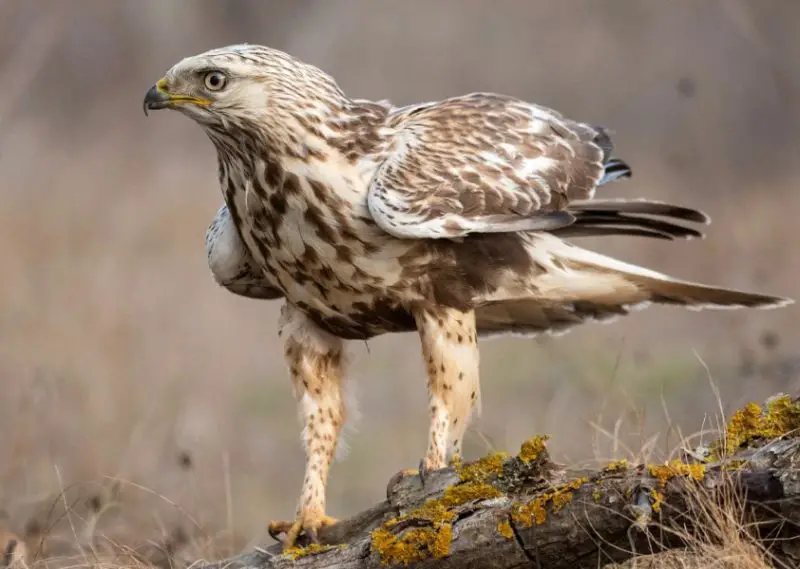
The Rough-legged Hawk is a winter visitor to Ohio, breeding in the Arctic tundra and arriving in the state during the cold months. It’s a large hawk with long, broad wings and a wide tail. This species gets its name from its feathered legs, which help keep it warm in freezing temperatures. Plumage varies, but most show dark “wrist” patches on the wings and a dark belly band.
These hawks typically measure 18 to 24 inches in length and have wingspans of 52 to 54 inches. In Ohio, they are seen in open fields, farmlands, and grasslands, especially in the western and northern parts of the state. They often hover while hunting, a trait they share with the much smaller American Kestrel.
Their primary food source is small rodents, especially voles. Rough-legged Hawks hunt from perches or by hovering in place, scanning the ground below for movement. Their talons are not as strong as other hawks’, but they’re well adapted for capturing lighter prey in wide open spaces.
They nest on cliffs or in trees in the Arctic during summer and migrate south for the winter. A fun fact: Unlike most hawks, Rough-legged Hawks have highly variable color morphs—light and dark forms—which can make identification a fun challenge for birdwatchers.
Northern Goshawk (Accipiter gentilis)

The Northern Goshawk is the largest and most powerful of the Accipiter hawks in North America. Adults have striking gray plumage, a broad chest, red eyes, and bold white stripes over the eyes that look like eyebrows. Juveniles are brown with heavy streaking and pale yellow eyes. Goshawks have broad wings and a long tail, helping them maneuver skillfully through forests.
These raptors measure 20 to 26 inches in length and have wingspans between 40 to 46 inches. They are rare visitors to Ohio, typically seen only in winter and mainly in remote, forested areas in the northeast. Because of their secretive nature and preference for deep woods, sightings in the state are sporadic and thrilling for birders.
Northern Goshawks are fierce and relentless hunters. They feed on a variety of prey including rabbits, squirrels, grouse, and other birds. Their hunting style includes powerful dashes through trees and underbrush to ambush prey. They are known for defending their nests aggressively—even against humans.
Nesting mostly occurs in large coniferous or mixed forests in Canada and the northern U.S. A fun fact: In medieval times, Northern Goshawks were prized in falconry and reserved for nobility due to their strength, courage, and hunting skill.
Swainson’s Hawk (Buteo swainsoni)
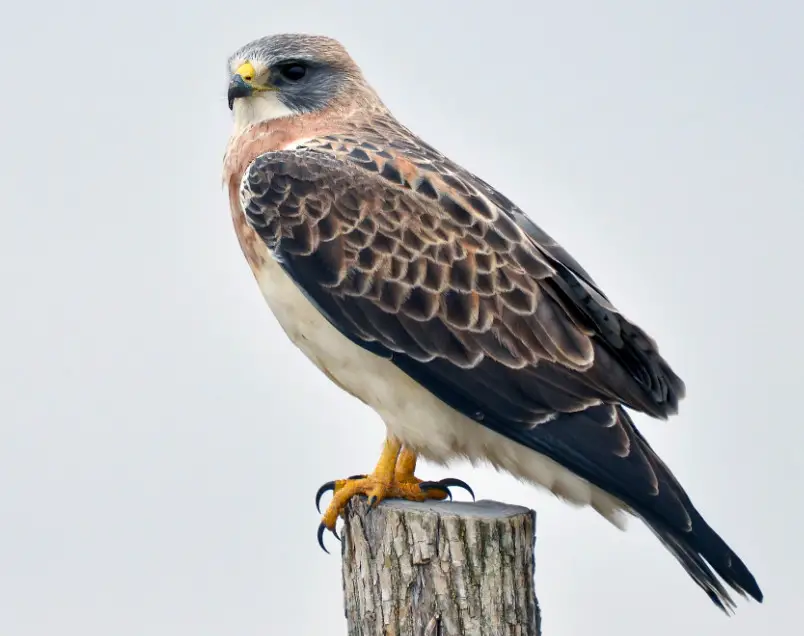
Swainson’s Hawk is a long-distance migrant rarely seen in Ohio, usually during spring or fall migration. It is a slim Buteo with long pointed wings and a small head. Adults are typically brown on the back with a pale underside and a dark chest patch. Their tails are usually gray with narrow bands. Light and dark morphs exist, but most individuals in the East are light-morph.
They range from 18 to 22 inches in length, with wingspans between 45 and 55 inches. While their breeding range is primarily in the western U.S., some vagrant individuals may drift east into Ohio, particularly in open agricultural areas or during migration periods.
Swainson’s Hawks have a unique diet compared to other hawks—they primarily eat insects like grasshoppers, crickets, and beetles, especially during migration and on their wintering grounds in South America. During the breeding season, they also hunt small mammals, reptiles, and birds.
They nest in isolated trees or on utility poles in prairies or farmlands in the western U.S. A fun fact: Swainson’s Hawk undertakes one of the longest migrations of any raptor, traveling over 6,000 miles to winter in Argentina—earning it the nickname “grasshopper hawk.”
Ferruginous Hawk (Buteo regalis)
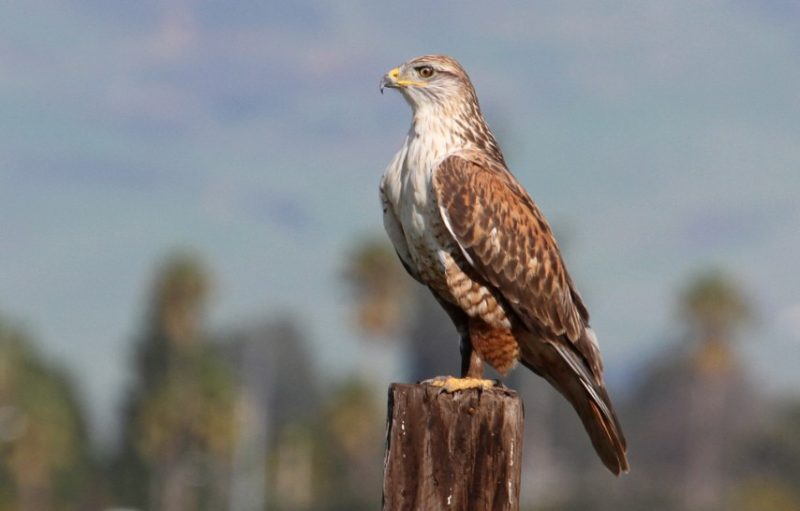
Ferruginous Hawks are the largest Buteo hawks in North America and are extremely rare in Ohio, typically seen as accidental vagrants. Their name refers to their rust-colored (ferruginous) back and legs. These hawks have long wings, large heads, and legs fully feathered to the toes. Light morphs have pale underparts and a reddish back, while dark morphs are mostly chocolate brown.
They measure 22 to 27 inches in length and have an impressive wingspan of 52 to 60 inches. Ferruginous Hawks are built for wide open spaces and are most commonly found in the western U.S. in grasslands and deserts. In Ohio, they may occasionally appear in open fields during migration or winter, though sightings are extremely uncommon.
Their diet consists mainly of ground-dwelling mammals like prairie dogs, ground squirrels, and rabbits. They may also take birds and reptiles. They often hunt by soaring, hovering, or waiting on elevated perches before swooping down.
They nest on cliffs, ground mounds, or even on large hay bales in the West. A fun fact: Ferruginous Hawks have a high tolerance for heat and are known to nest in open sun without shade, a rare trait among raptors.
Frequently Asked Questions About Hawks in Ohio
What is the most common hawk in Ohio?
The Red-tailed Hawk is the most common and widespread hawk species in Ohio. It can be seen year-round in a variety of habitats including forests, fields, and urban areas.
When is the best time to see hawks in Ohio?
Hawks can be seen year-round in Ohio, but the best times to observe them are during spring and fall migration seasons when many species pass through the state in large numbers.
Do hawks in Ohio migrate?
Yes, some hawk species in Ohio migrate. For example, Broad-winged Hawks and Swainson’s Hawks undertake long migrations to Central and South America. Other species, like Red-tailed Hawks and Cooper’s Hawks, are generally year-round residents.
What do hawks in Ohio eat?
Hawks in Ohio eat a variety of prey including small mammals (mice, rabbits, squirrels), birds, reptiles, amphibians, and insects. Diet varies by species and habitat.
Where do hawks in Ohio nest?
Most hawks nest in trees, often in tall, mature forests or wooded areas near open fields. Some species, like the Northern Harrier, nest on the ground in dense grass or marshes.
Are any hawks in Ohio endangered?
Most hawk species in Ohio are not endangered, but they benefit from habitat protection and clean environments. Occasional rare visitors, like the Northern Goshawk, are less commonly seen.
Can hawks help control pests in Ohio?
Yes, hawks play an important role in controlling rodent and insect populations, making them beneficial for maintaining healthy ecosystems and even helping farmers.

